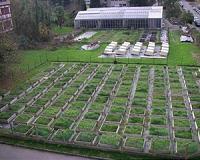| . |  |
. |
Madison WI (SPX) Mar 09, 2011 North and South Carolina have seen a steady increase in swine production over the last 15 years. In North Carolina alone, swine production generates approximately a quarter of the state's gross farm receipts. The presence of so many large-scale pig farms leads to the problem of proper animal waste disposal. The most common practice in the Carolinas is storing animal waste in anaerobic lagoons. They are primarily used to concentrate and passively treat urine and feces but because of the widespread use of this practice, the environmental impact could be quite severe. Conflicting reports implicate lagoon sites to be responsible for high emission rates of nitrogen gas and volatized ammonia. A team of ARS-USDA scientistsexamined a series of commercial, anaerobic, swine wastewater lagoons in North and South Carolina for genes involved in the nitrogen cycling process. Nitrification and denitrification are the parts of the process responsible for turning ammonia into nitrogen gas. After analyzing eight lagoons and measuring the abundance of four nitrogen cycling genes, researchers concluded that the denitrifying and nitrifying organisms were not active despite there being a thriving amount. Acidification and eutrophication of the surrounding ecosystem could be the result of prolonged exposure to volatilized ammonia. Thomas F. Ducey, one of the authors of the study says, "These anaerobic lagoons have relatively consistent levels of nitrogen-cycling genes throughout their water column. While they are similar to natural ecosystems, they are not as high as some wastewater treatment system. Moreover, these gene levels did not translate into the high denitrification enzyme activity that is typical of wastewater treatment systems." Ducey adds, "The work is part of the ARS Agricultural and Industrial Byproducts National Program, which has the mission to effectively and safely manage and use manure and other agricultural and industrial byproducts in ways that maximize their potential benefits while protecting the environment and human and animal health."
Share This Article With Planet Earth
Related Links American Society of Agronomy Our Polluted World and Cleaning It Up
 Protecting Ecosystems, Pollution Remediation Goals Of Research
Protecting Ecosystems, Pollution Remediation Goals Of ResearchHouston TX (SPX) Mar 09, 2011 Cleaning up pollution, protecting soil from erosion and maintaining species-rich ecosystems are some of the goals of a computational ecology project by a University of Houston (UH) scientist and his team. Published recently in a top journal, the work sheds light on a new method to speed up research in the ecology of plants. Marc Garbey, a professor of computer science and mathematics at UH ... read more |
|
| The content herein, unless otherwise known to be public domain, are Copyright 1995-2010 - SpaceDaily. AFP and UPI Wire Stories are copyright Agence France-Presse and United Press International. ESA Portal Reports are copyright European Space Agency. All NASA sourced material is public domain. Additional copyrights may apply in whole or part to other bona fide parties. Advertising does not imply endorsement,agreement or approval of any opinions, statements or information provided by SpaceDaily on any Web page published or hosted by SpaceDaily. Privacy Statement |